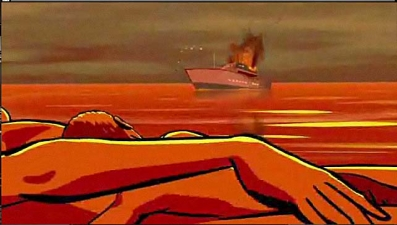Waltz With Bashir (Ari Folman, 2008): Israel / Germany / France
Reviewed by Marissa Vogt. Viewed at the AFI Film Festival, ArcLight Hollywood.
Walking into the film, Waltz with Bashir, I had no knowledge of the films content other than it told the story of an Israeli war veteran returning home, and that it was an animated feature. Little did I know I was about to view a documentary built on the dream states and memories of the young men who fought in the invasion of Lebanon. All of this was to be set to a soundtrack of classical waltzes, hopping techno beats, and unnervingly poppy music.
The opening scene in Waltz with Bashir sets the tone for the entire movie, featuring a recurring dream of a man who is being haunted by a ravishing pack of wild dogs to a grinding background melody. The dogs and the dream belong to a friend of Ari Folman’s, who he met while in the military. The friend asks Ari to make a film about the events of the war so that he may finally put the dreams to rest. That night, Ari has his first flashback to the war which triggers his desire to investigate the memories he has forgotten, and he uses those around him to piece together the traumatic past of a war-torn country.
Ari’s flashback is one of himself and two others swimming in the waters of a sea watching the incoming flares over a refugee zone, in which most of the people are then massacred. He attempts to find those in his memories and those who he fought with in order to gain perspective on the situation he may have intentionally blocked out. He discovers poignant memories that illuminate the rationality of a generation and the plot that has led to the world which we now know.
Though the title is intended to be taken figuratively, Waltz with Bashir, the music in the film does a great job using the term waltz literally. The music in the film enhances all aspects, from showing the hunger and terror of the incoming pack of dogs to the loneliness of Ari in his search. Notably, some of the battle scenes are cut to classical music, the tempo of the waltzes in time with the movements of the men and the shooting of their weapons. For most of the fighting, whether it’s meant to be portrayed as a dream state/memory or just the artistic rendering, the soldiers appear to be dancing.
Another humorous musical addition is the scene when Ari and his troops are stationed at a beach. They are exuberant, surfing during the day and drinking at night. Though on the front of war they are having the time of their lives, and in the background an upbeat pop song is playing which vocalizes killing Lebanese people. The Monkees would have been proud if they could have created something as catchy as this song, though the lyrics might have not been their style. The beach scene ends with the troops blowing up tanks in rhythm to the music.
The film transitions seamlessly between the ecstasy of youth and the horrors witnessed by a group of young men; in some moments they almost appear to be vacationing. This seems to be a coping technique for the management of death and hopelessness. The scenes in this film are extraordinary and powerful, and explanatory for a generation that has no idea why the world is the way it is. Innovative and incredible: I loved this film.
About this entry
You’re currently reading “Waltz With Bashir (Ari Folman, 2008): Israel / Germany / France,” an entry on Student Film Reviews
- Published:
- 11.10.08 / 12am
- Category:
- AFI Filmfest 2008, Animation, Documentary, Films

3 Comments
Jump to comment form | comments rss [?] | trackback uri [?]